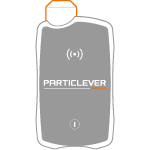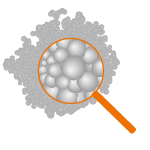Evaluating exposure in steps
Whether or not the particles investigated are nanoparticles, PARTICLEVER recommends following the nanoparticle exposure assessment strategy published by the OECD (Series on the Safety of Manufactured Nanomaterials #55 - env-jm-mono(2015)19), which was chosen as a basis for the future European standard EN 17058 with regard to the methodology for assessing exposure to nano-objects and their aggregates and agglomerates. This standard is currently being written on a mandate from the European Commission.
Generally speaking, this approach is perfectly suitable for all advanced materials, and even more broadly for already-known particle substances whose limit values have not yet been properly identified or for which the analyses remain experimental.
Given the paucity of feedback on the investigated particles, the approach consists of taking a measurement as soon as particle risk is suspected or identified within the workplace.
The first level of intervention consists of evaluating the situation in order to prove that the investigated particles are present in the air at the workplace.
The second level of intervention consists of verifying whether the exposure is real, while providing the first quantification information.
The third level corresponds to an expert assessment in order to accurately characterize exposure based on numerous metrics.

Description of missions
1. Initial assessment
The first level of intervention consists of identifying situations where the risk that suspected particles have been emitted or released is real. It consists of detecting the areas and the operations in question.
The conclusion of this step is the confirmation that the suspected particles are present at the workplace. Although this step gives precedence to documentation and observation, it may be very useful to carry out measurements, particularly as close as possible to the sources, in order to identify whether the particles are present.
At the end of this step, if their presence is proven, the corresponding risk may be entered in the establishment’s professional risk document.
2. Basic exposure assessment
At this level of intervention, potentially risky situations are identified. The goal is to confirm whether or not there has been exposure to the investigated particles, while providing the first quantitative information.
The protocol applied in this case is bare-bones, and consists of using simple devices such as the PARTICLEVER Sampler.
If exposure is confirmed, a decision may be made to work to reduce the exposure or move on to the next level of intervention. This choice will be based on the results and on the types of substances.
After setting up risk reduction measures, a new basic assessment will be carried out in order to verify that exposure has been reduced.
3. Professional expert exposure assessment
When a level of exposure seems to have been sufficiently tested, a campaign aimed at thoroughly measuring residual exposure is carried out.
When this happens, numerous metrics are added to the basic metrics already used in the previous intervention level in order to have complete information in terms of characterizing the exposure.
In the absence of regulatory limit values, continual improvement of the exposure must be pursued.



